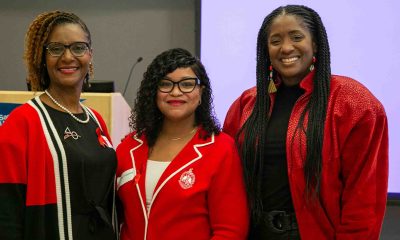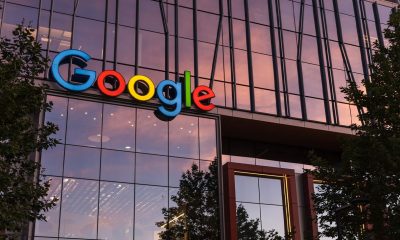Technology
Google Embeds Engineers as Professors

Google software engineer and Google In Residence Sabrina Williams talks with students during a Google Student Development class on Impostor Syndrome at Howard University in Washington, Tuesday, April 14, 2015.(AP Photo/Molly Riley)
Martha Mendoza, ASSOCIATED PRESS
MOUNTAIN VIEW, Calif. (AP) — Howard University freshman Alanna Walton knew something was different about the professor teaching her introduction to computer science course.
First, there was her name: Professor Sabrina. She was an African American woman, kept office hours until 2 a.m. if that’s what it took to see everyone, and had an additional title: Google In Residence.
“It was an awesome class,” said Alanna who has already chosen her major at the Washington D.C.-based university: computer science.
In ongoing efforts to diversify Silicon Valley’s tech sector, Google is embedding engineers at a handful of Historically Black Colleges and Universities where they teach, mentor and advise on curriculum.
Today 35 percent of African Americans receiving computer science degrees come from those schools, but they don’t make their way to Silicon Valley’s top tech firms. Google is typical — about 1 percent of its technical staffers are black.
Last year a push by civil rights advocate Jesse Jackson prompted several dozen tech firms to release workforce diversity data which showed under-representation of African Americans, Latinos and women in the field.
In response, businesses, universities and community leaders have launched initiatives aimed at diversifying their ranks, both ethnically and by gender. The Anita Borg Institute and the National Center for Women and Information Technology have partnered with many companies to support female engineers.
Facebook offers “Facebook University,” an internship for low income minority college freshmen interested in computer science. Intel has committed $300 million over the next five years toward diversifying its workforce, while Apple has a $50 million partnership with nonprofits to support women and minority computer science majors.
Google decided to go to the source, sending a handful of software engineers to teach at Howard, Hampton University in Hampton, Virginia, Fisk University in Nashville, and Spelman and Morehouse colleges in Atlanta.
They taught introductory courses, but they also trained students on everything from how to send a professional email to how to make it through a software engineering job interview, which can involve a lot of time solving coding questions at a white board.
This summer, 30 of those students will be Google interns. And Howard University graduating senior Christopher Hocutt, 21, whose friends jokingly call him Mr. Google, will be starting at the company full-time.
Hocutt said the Google In Residence professors convinced him to apply.
“What they discovered was a lot of people weren’t even applying to Google because we didn’t believe we were skilled enough to do it,” he said. “Once we realized we have the skills, we just needed mentorship to make our resume look good, get through the interview, have confidence to try.”
Google software engineer Sabrina Williams, who took a semester away from her Mountain View campus this year to mentor and teach at Howard, is thrilled to see her student becoming a colleague.
“I’m inspired,” she said. “Change is slow, this is going to take time, but I think what’s interesting about this program is that it’s a different way of attacking the problem of lack of diversity in tech.”
Fifteen years ago, Williams was the only female African American computer science major at Stanford University. “I kind of felt awkward so I kind of hid a lot,” she said. “It was very difficult.”
She said that while “teaching is hard” and the hours at Howard were grueling, she welcomed the opportunity to offer students an experience different from her own. This included taking female computer scientists aside early in the semester, telling them she was available for any questions, and encouraging them to support each other.
Legrand Burge, who chairs Howard University’s computer science department, welcomes the temporary addition of Google engineers to his faculty.
“They’re not academics but they have domain expertise that students could definitely learn a lot from,” he said. “The word got out and it actually got a lot of students interested in computer science who didn’t initially plan to study it.”
Indeed, class sizes have doubled in intro courses. Williams had 70 students in one class; about 250 were taught so far this year by Google engineers at all five schools.
In the 1970s and 80s a similar program partnered the university with AT&T, Bell and Hewlett Packard, Burge said. This time, he said, Google is bringing a disruptive, Silicon Valley mentality to their campus.
“The issue with the East Coast and West Coast ecosystem, is that in the West there’s a fail fast, fail often mentality,” Burge said. “And there’s a disconnect between academia, which does not have that try things out, dare to experiment, fail and learn about why you failed, come back and do better, culture.”
___
Follow Martha Mendoza @mendozamarthaap.
Copyright 2015 The Associated Press. All rights reserved. This material may not be published, broadcast, rewritten or redistributed.
###
Activism
Self-eSTEM Empowers BIPOC Women, Girls in Science, Math
In January 2025, Self-eSTEM will launch digital and generative AI programming, which provides digital literacy and AI literacy training through an entrepreneurial project-based activity. This programming will be a hybrid (i.e. in-person and online). Additionally, thanks to a grant from Comcast, in spring 2025, the organization will have a co-ed series for middle and high school students.

By Y’Anad Burrell
Special to The Post
In a world where technology plays an increasingly central role in all aspects of life, the importance of Science, Technology, Engineering, and Math (STEM) education cannot be overstated. Recognizing the significance of STEM for the future, focusing on young women and girls is a critical step in achieving gender equality and empowering the next generation.
Self-eSTEM, an Oakland-based non-profit organization, was founded by Adamaka Ajaelo, an Oakland native who had a successful corporate career with several Bay Area technology and non-tech companies. Ajaelo boldly decided to step away from these companies to give 100% of her time and talent to the non-profit organization she started in 2014 in the belief that she can change the game in innovation and future STEM leaders.
Over the course of a decade, Ajaelo has provided futurist tech programming to more than 2,000 BIPOC women and girls. The organization has an Early STEM Immersion Program for ages 7-17, Emerging Leaders Workshops for ages 18-25 and volunteer network opportunities for ages 25 and up.
In January 2025, Self-eSTEM will launch digital and generative AI programming, which provides digital literacy and AI literacy training through an entrepreneurial project-based activity. This programming will be a hybrid (i.e. in-person and online). Additionally, thanks to a grant from Comcast, in spring 2025, the organization will have a co-ed series for middle and high school students.
While the organization’s programs center on innovation and technology, participants also gain other valuable skills critical for self-development as they prepare for a workforce future. “Self-eSTEM encourages young women to expand on teamwork, communication, creativity, and problem-solving skills. The organization allows young women to enter STEM careers and pathways,” said Trinity Taylor, a seventh-year innovator.
“Our journey over the last decade is a testament to the power of community and opportunity, and I couldn’t be more excited for what the future holds as we continue to break barriers and spark dreams,” said Ajaelo.
“By encouraging girls to explore STEM fields from a young age, we foster their intellectual growth and equip them with the tools needed to thrive in a competitive global economy,” Ajaelo says.
Empowering young girls through STEM education is also a key driver of innovation and progress. When young women and girls are encouraged to pursue careers in STEM, they bring unique perspectives and problem-solving approaches to the table, leading to more diverse and inclusive solutions. This diversity is crucial for driving creativity and pushing boundaries in scientific and technological advancements.
Self-eSTEM has fundraising opportunities year-round, but year-end giving is one of the most critical times to support the program. Visit www.selfestem.org to donate to the organization, as your generosity and support will propel programming support for today’s innovators.
You will also find more details about Self-eSTEM’s programs on their website and social channels @selfestemorg
Antonio Ray Harvey
Feds: California Will Be Home to New National Semiconductor Technology Center
California was chosen by the U.S. Department of Commerce (Commerce) and Natcast, the operator of the National Semiconductor Technology Center (NSTC) to be home to the headquarters for the National Semiconductor Technology Center – as part of the Biden-Harris Admin’s CHIPS and Science Act. The CHIPS for America Design and Collaboration Facility (DCF) will be one of three CHIPS for America research and design (R&D) facilities and will also operate as the headquarters for the NTSC and Natcast.

By Antonio Ray Harvey
California was chosen by the U.S. Department of Commerce (Commerce) and Natcast, the operator of the National Semiconductor Technology Center (NSTC) to be home to the headquarters for the National Semiconductor Technology Center – as part of the Biden-Harris Admin’s CHIPS and Science Act.
The CHIPS for America Design and Collaboration Facility (DCF) will be one of three CHIPS for America research and design (R&D) facilities and will also operate as the headquarters for the NTSC and Natcast.
“We are thrilled that the Department of Commerce and Natcast chose to locate this critically important facility in Sunnyvale, the heart of the Silicon Valley, alongside the world’s largest concentration of semiconductor businesses, talent, intellectual property, and investment activity,” said Dee Dee Myers, Senior Economic Advisor to Gov. Gavin Newsom and Director of the Governor’s Office of Business and Economic Development (GO-Biz). “The Newsom Administration and our partners across the industry know how important it is to shorten the timeframe from R&D to commercialization.”
According to GO-Biz, the DCF is expected to direct over $1 billion in research funding and create more than 200 employees in the next decade. The facility will serve as the center for advanced semiconductor research in chip design, electronic design automation, chip and system architecture, and hardware security. The CHF will be essential to the country’s semiconductor workforce development efforts.
As detailed in the released NSTC Strategic Plan, the DCF will suppress the obstacles to “semiconductor prototyping, experimentation,” and other R&D activities that will enhance the country’s global power and leadership in design, materials, and process innovation while enabling a vigorous domestic industr“Establishing the NSTC headquarters and design hub in California will capitalize on our state’s unparalleled assets to grow a highly skilled workforce and develop next-generation advancements,” stated U.S. Sen. Alex Padilla (D-Calif.). “This CHIPS Act funding will propel emerging technologies and protect America’s global semiconductor leadership, all while bringing good-paying jobs to our state.”
Community
Advanced Conductors Provide Path for Grid Expansion
Utility companies in the United States could double electric transmission capacity by 2035 by replacing existing transmission lines with those made from advanced materials, according to a new study published Monday in the Proceedings of the National Academy of Sciences.

By Matthew Burciaga
UC Berkeley News
Utility companies in the United States could double electric transmission capacity by 2035 by replacing existing transmission lines with those made from advanced materials, according to a new study published Monday in the Proceedings of the National Academy of Sciences.
Led by Duncan Callaway, professor and chair of the Energy and Resources Group (ERG), and Amol Phadke, an affiliate and senior scientist at the Goldman School of Public Policy, the first-of-its-kind study details a faster and more cost-effective way to expand the grid and connect the more than 1,200 gigawatts of renewable energy projects awaiting approval. The analysis was first published last December as a working paper by the Energy Institute at Haas and has been covered by the New York Times, the Washington Post, Heatmap News, and other news outlets.
“Expanding transmission capacity is critical to decarbonization, and we sought to study ways to build it faster and cheaper,” said Callaway.
It currently takes 10 to 15 years to build a new power line and the U.S. is building transmission lines at a lower rate than it was in the past decade. Without sufficient capacity, renewable energy projects often sit in limbo for years as transmission operators study what upgrades—if any—are needed to accommodate the increased loads.
The authors modeled various scenarios to determine if replacing existing transmission conductors with those made with advanced composite-core materials—a process known as reconductoring—could provide a pathway to faster grid expansion.
Several reconductoring projects have been initiated in Belgium and the Netherlands, and utility companies in the U.S. have used the material to string transmission lines across wide spans like river crossings. That technology, however, has not made its way to the majority of overhead power lines that feed residential and commercial customers.
“As we learned more about the technology, we realized that no one had done the detailed modeling needed to understand the technology’s potential for large-scale transmission capacity increases,” said Phadke.
Based on the authors’ projections, it is cheaper—and quicker—for utility companies to replace the 53,000 existing transmission lines with advanced composite-core materials than it is to build entirely new transmission lines.
They assert that doing so would reduce wholesale electricity costs by 3% to 4% on average—translating to $85 billion in system cost savings by 2035 and $180 billion by 2050.
“The level of interest we’ve received from federal and state agencies, transmission companies and utilities is extremely encouraging, and since our initial report, the Department of Energy has committed hundreds of millions of dollars to reconductoring projects,” said co-author Emilia Chojkiewicz, a PhD student in ERG and an affiliate of the Goldman School of Public Policy. “We are looking forward to learning about these projects as they unfold.”
Additional co-authors include Nikit Abhyankar and Umed Paliwal, affiliates at the Goldman School of Public Policy; and Casey Baker and Ric O’Connell of GridLab, a nonprofit that provides comprehensive technical grid expertise to policy makers and advocates.
-

 Activism4 weeks ago
Activism4 weeks agoOakland Post: Week of November 27 – December 3, 2024
-

 Activism3 weeks ago
Activism3 weeks agoButler, Lee Celebrate Passage of Bill to Honor Congresswoman Shirley Chisholm with Congressional Gold Medal
-

 Activism3 weeks ago
Activism3 weeks agoPost News Group to Host Second Town Hall on Racism, Hate Crimes
-

 Activism3 weeks ago
Activism3 weeks agoDelta Sigma Theta Alumnae Chapters Host World AIDS Day Event
-

 Business3 weeks ago
Business3 weeks agoLandlords Are Using AI to Raise Rents — And California Cities Are Leading the Pushback
-

 Arts and Culture2 weeks ago
Arts and Culture2 weeks agoPromise Marks Performs Songs of Etta James in One-Woman Show, “A Sunday Kind of Love” at the Black Repertory Theater in Berkeley
-

 Activism6 days ago
Activism6 days agoBooks for Ghana
-

 Activism3 weeks ago
Activism3 weeks agoOakland Post: Week of December 4 – 10, 2024






























































